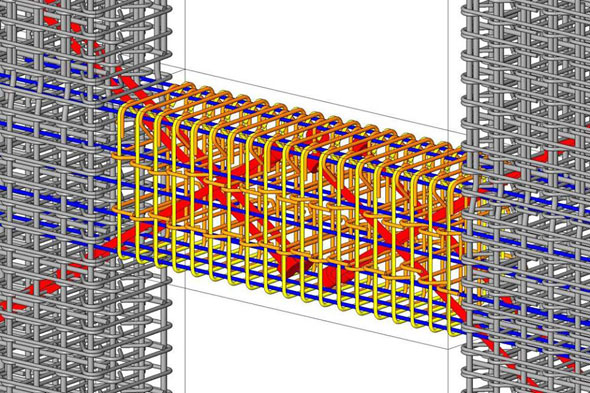Brief overview of reinforced concrete coupling beam
- Concrete Cost Estimator
- Concrete Continuous Footing
- Landscape Bidding and Estimating
- Construction Cost Estimating
- Concrete and steel cost estimation
- Construction Cost Estimate Breakdown
- Construction Estimating Worksheet
- Home Construction Cost Estimate
- Estimate Pricing Sheet
- Sheet for General Contractor
- Construction Cost Estimate
- Labor Materials Cost Estimator
- Masonry Estimating Sheet
- Sheet for Building Contractor
- Construction Schedule Bar chart
- General Cost Estimator Sheet
- General Construction Estimate
- Building and Road Estimating Sheet
- Detailed expense estimates
- Door and Window Takeoff Sheet
- General Construction Cost Estimating Sheet

In order to prevent loads of earthquake, a strong structural system should be constructed with reinforced concrete (RC) shear walls linked by coupling beams.
Generally concrete structural walls are considered as the most important lateral force that can prevent system for both medium and high-rise concrete and steel frame structures.
With the combination of solidity and potency, structural walls produce a significant amount of lateral force that withstands earthquake bringing displacement reversals. The effectiveness of a structural wall system is enhanced by integrating two or more successive walls with the application of short coupling beams.
This coupling action minimizes the requirement for flexural rigidity and strength from the individual walls through their axial stiffness, strength, and the distance connecting the centroidal axes of adjoining walls to get supplementary resistance to overturning moment.
A coupled wall system can perform satisfactorily throughout a seismic event, if the short coupling beams maintain a considerable, and expected, strength and stiffness by large displacement reversals. To guarantee sufficient coupling beam ductility is attained, the ACI Building Code vide ACI Committee 318, 2008, needs that diagonal reinforcement must be provided to combat with all of the shear demand in short and highly stressed coupling beams. Several researchers have focused on this reinforcement detail to present a steady behavior under earthquake-type displacement reversals, but this process is complicated as well as lingering to form.
It is discovered from latest coupling beam component tests (Canbolat, Parra-Montesinos, and Wight, 2005; Lequesne et al., 2009) that precasting coupling beams having strain-hardening, High Performance Fiber Reinforced Concrete (HPFRC) can make the construction process simplier by maintain the performance level. The HPFRC coupling beams are provided with an extremely ductile behavior after depending on large displacement reversals, devoid of involving considerably easy to use reinforcement detailing as compared to reinforced concrete beams.
The effect that the ductility demonstrated through HPFRC coupling beams at the component level is provided on a coupledwall system, though, it is not tested practically. The test is based on the study of interaction connecting precast HPFRC coupling beams and structural walls, with particular emphasis given on the ductility and strength retention concerning the system and the deformation demands that every system component is dependent.
www.concretesdc.org/meetings/Past_Meeting&Sessions/Session28/8.pdf

- Application of concrete calculator
- Roofing Calculator can streamline the roof estimating process
- House construction cost calculator
- Engineering column design excel spreadsheet
- Material Estimating Sheet with Excel
- Materials List and Cost Estimate Worksheet
- Concrete Slab Estimating Calculator Sheet
- Common types of foundations for buildings
- Online calculation of construction materials
- Estimating with Excel for the Small Contractor
- Concrete Beam Design Spreadsheet
- Virtual Construction Management app for construction
- Autodesk’s Project Skyscraper
- Reed Construction’s Reed Insight
- Manage your construction project documentation
- Costimator, the popular cost estimating software
- On Center Software for construction professionals
- Free Construction Estimating Software
- Plumbing Calc Pro
- Cost Estimate Worksheet
- HVAC Piping Quantity Takeoff Worksheet
- Construction Estimating Software Sheet
- Estimate Cost Templates
- Construction Punch List
- Construction cost estimating template consisting estimating basic
- Gantt Chart Template for Excel
- Download Civil Engineering Spreadsheets with Verification
- The Building Advisor Estimating and Budgeting Worksheet
- Spreadsheet for design of concrete bridge
- Construction Estimating Software Free








